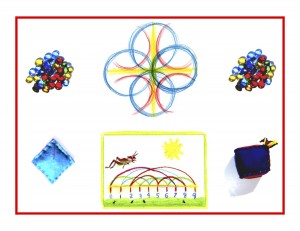Day 27
For one year, 365 days, this blog will address the Common Core Standards from the perspective of creating an alternate, ambient learning environment for math. Ambient is defined as “existing or present on all sides, an all-encompassing atmosphere.” And ambient music is defined as: “Quiet and relaxing with melodies that repeat many times.”
Why ambient? A math teaching style that’s whole and all encompassing, with themes that repeat many times through the years, is most likely to be effective and successful. Today’s blog will focus on the Kindergarten Common Core Math Standards and ambient counterparts that appeared in this blog on Days 13, 15, and 16. Note: standards may be paraphrased and will appear in blue.
In the Waldorf School, learning about time and measurement does not happen until third grade. As with many other elements, exposure to time and measurement will most likely happen way before third grade, but its formal introduction doesn’t happen till then. The reasoning is that the child crosses a significant boundary at age 9. Just as a readiness for learning becomes optimal at age 7, the first real steps out of the garden of childhood are taken two years later, at 9.
Creation stories are told at this age, as the child’s powers of reasoning develop alongside a beginning recognition of the realities of growing up. The expulsion from the garden is a thread that runs through most cultures’ creation stories, and is a theme that fits this stage of development well. This age then also becomes a perfect window to teach practical things like housebuilding and farming / gardening, because that’s how we collectively learned to live on the earth, on our own, after leaving our respective gardens. Time and measurement fit this context nicely. That said, aspects of it can be taught and absorbed (rather than learned) in a purely experiential and playful way.
Day 13
Measurement and Data K.MD
Describe and compare measurable attributes.
1. Explore measurable attributes of objects like length or weight, experience and describe several measurable attributes of a single object.
Gathering small objects for a simple, close game of catch should happen one-on-one, adult to child at first. This could fit into the free play time in a subtle way, with the objects in a basket by your side, casually initiating the game. Because imitation is so strong now, showing the unique qualities of each object as you select, handle, and exchange each one would be optimal. Choose objects that would be suitable to eventually be made available for play in the Math Corner. Tell the Stone Soup story from the Day 21 post (or another version) before exploring the properties of the stone you will use to make stone soup. (Day 14 is devoted to cooking in general, and making the stone soup, so it will appear in the Snack/Story segment.)
Day 15
Measurement and Data K.MD
3. Sort different objects into categories, and determine the relative numbers of each.
Today’s activity is simple and straightforward. Mixing three different collections of natural objects together in varying amounts and providing three empty baskets to sort them into fulfills this standard, short of counting the objects in each basket. A feel for the volume of each is how their relative amounts will be experienced. Your Kindergartner loves to sort, and s/he will be happily engaged with this, with or without your guidance. Do connect it to one of the classic fairy tales after telling the story, for added fun and relevance.
Geometry is touched on informally from the Waldorf first to fifth grades, through form drawing. It is taught formally with precision and instruments in the sixth grade. The Platonic Solids are examples of forms that are deeply archetypal. Form drawing is approached and taught with an awareness of this, and it does resonate very deeply for the children. As a Waldorf class teacher, I began each school year with a week of form drawing main lessons every day, and brought it back every Monday for the whole year. A playful approach is best for accessing the necessary archetypal mood now.
Day 16
Geometry K.G
Identify and describe shapes (squares, circles, triangles, rectangles, hexagons, cubes, cones, cylinders, and spheres).
1. Describe objects in the environment using names of shapes, and describe the relative positions of these objects using terms such as above, below, beside, in front of, behind, and next to.
As mentioned in this post, my internet search for hands-on activities resulted in a lot of worksheets and plastic shape sorting sets. Much more subtlety is needed here. Montessori uses sandpaper letters and numbers, but this will also do for experiencing the shapes and their differences. Please do have the child(ren) participate in making anything like this, it means so much to them to be doing useful work! After you’ve guided the child(ren) a bit with these they can be stored in the Math Corner for free play. Same for the “Guess the Shape” pouch. The large outlined shapes and the positioning activities will be covered in the Circle Time segment.
Knowledge ensues in an environment dedicated to imaginative, creative knowing, where student and teacher alike surrender to the ensuing of that knowledge as a worthy goal. More Kindergarten tomorrow!












